In Pursuit of Salamone
In the emptiness of the Argentine Pampas, a vision of modernity
James Oles
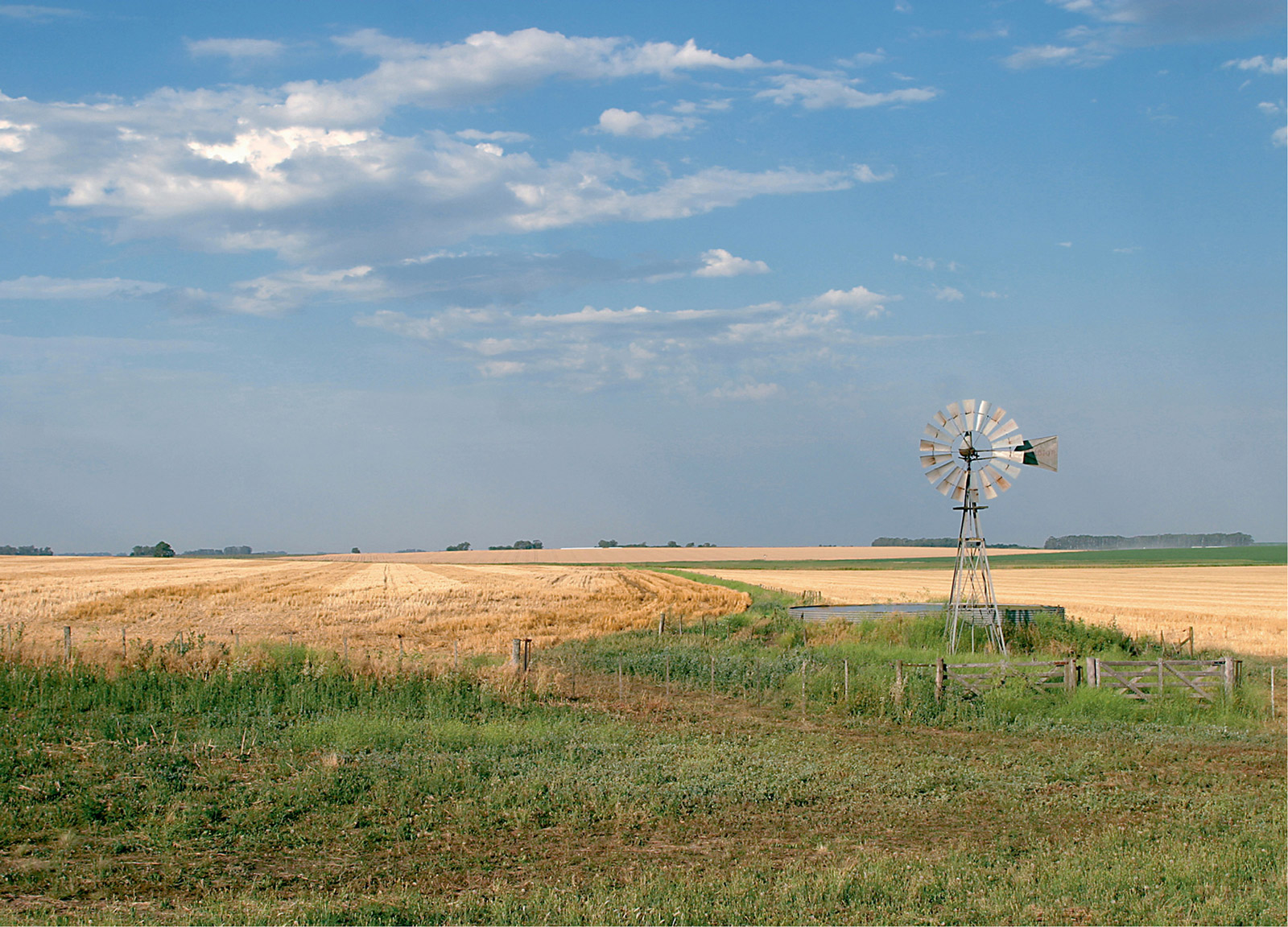
The longstanding cliché, promoted by local elites, is that Buenos Aires is the Paris of South America. But notwithstanding its beaux-arts palaces and Hausmannian perspectives, the city is more like Chicago. The capital stands with its back to the muddy waters of the Río de la Plata, looking out over a vast prairie that it had every reason to dominate and no pretense to fill, its dense verticality an arrogant rejection of the overabundant lands to the west, however much those lands generated the city’s wealth and its citizens’ sense of national, gauchesco identity.
Leave Buenos Aires by highway in any direction and you soon enter that endlessly flat expanse of agricultural fertility known as the pampa húmeda, the damp plain—six hundred thousand square kilometers of lush grasslands spreading out across the Provincia de Buenos Aires and beyond, contained by no political unit, and fading into the more sparsely populated and arid lands that abut the Andes to the west. This is the fabled Argentina, the once-frontier, now a center for global agribusiness that is displacing the sheep and cattle and, yes, the gauchos, with fields of soybeans and sunflowers. This is the campo that has driven the nation’s export economy and that has recently revolted against Peronist taxation plans. And this is the part of Argentina that the waves of post-corralito tourists—the ones who sought to benefit from favorable exchange rates after the crisis of 2001—hardly see, unless they are on quick overnight excursions to the old estancias that now survive by taking paying guests.
Inspired by the spooky pictorialist nocturnes of photographer Esteban Pastorino, my friend Marino Balbuena and I decided to drive off into the Pampas to see for ourselves the dozens of buildings and monuments completed there in the 1930s by Francisco Salamone. An architect literally as well as figuratively on the fringes of modernity, and associated with a discredited political regime, Salamone was largely ignored until the 1990s, when a few revisionist historians discovered, and then embraced, his quirky bastard style, a marriage of academic classicism and art-deco fantasy.[1] On three short trips in 2007 and 2008, we saw as many of his buildings as we could, using a cumbersome two-volume survey of his work as our primary guide.[2] Yet our pursuit of Salamone quickly devolved into something else: his monuments were destinations that allowed us to trace routes and then take detours, to experience the interstices not discussed by the architectural historians obsessed with plans and sources, to look for signs of a promised and then withdrawn future, to feel the heat coming off the plain.
From 1936 to 1940, as the world beyond spun into another global war, the wealthy Province of Buenos Aires was ruled by governor Manuel A. Fresco, a member of the Conservative Party and a fan of Mussolini. He militarized the police corps, mandated Catholic education in the schools, and promoted a right-wing criollo nationalism that must have troubled the immigrants from southern and central Europe who had populated much of the province in recent decades. Despite accusations of fraud, Fresco’s administration managed to revitalize a stagnating provincial economy and slowing down internal migration to the capital, a brain and tax drain that continues to plague the overly centralized nation. Reflecting, though on a much smaller scale, those labor-intensive projects that sought to transform Germany, Italy, and the United States in the same period, the Dirección de Arquitectura de la Provincia built roads, canals, and bridges, improved rural health and education, and funded new public buildings through a 1928 municipal bond law that promoted numerous local projects.
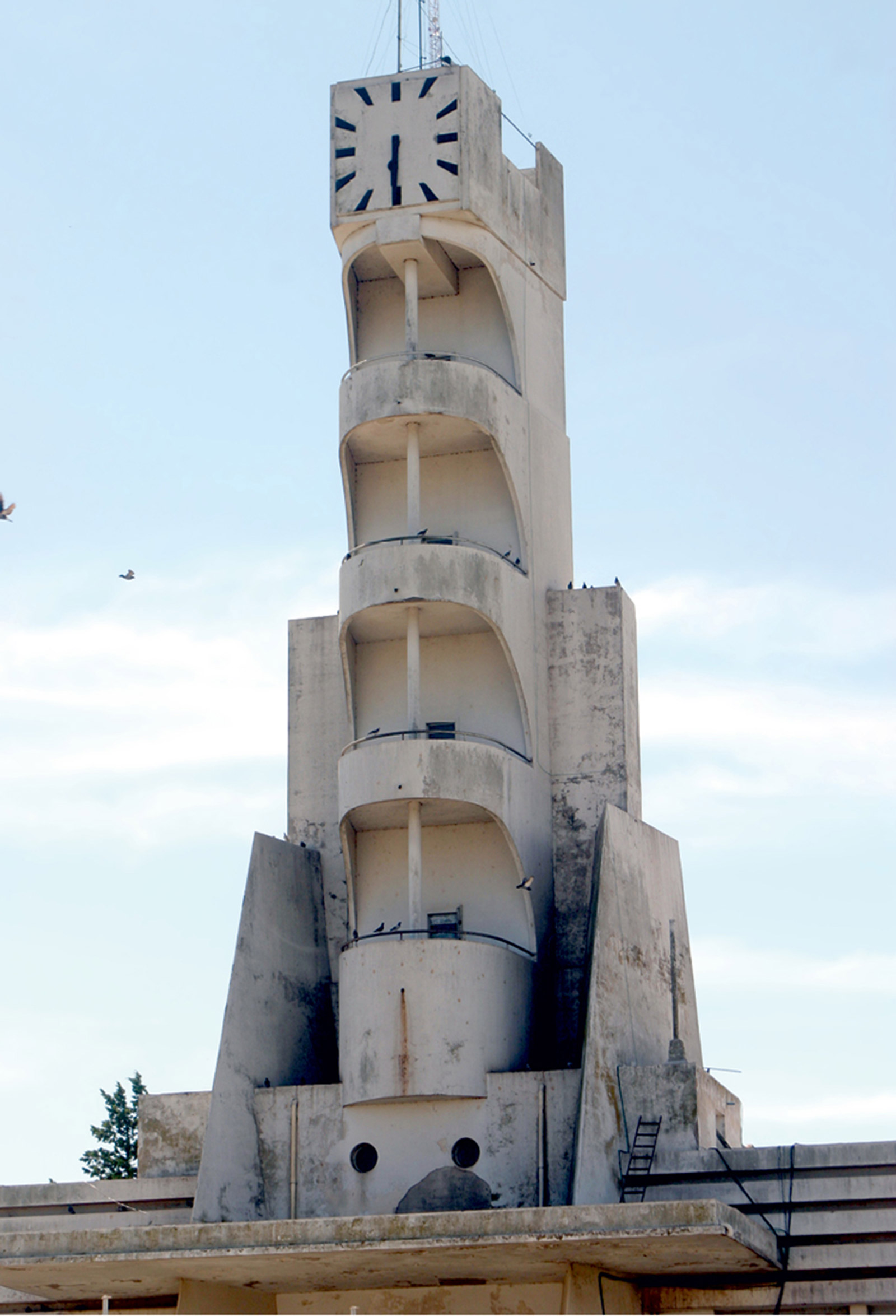
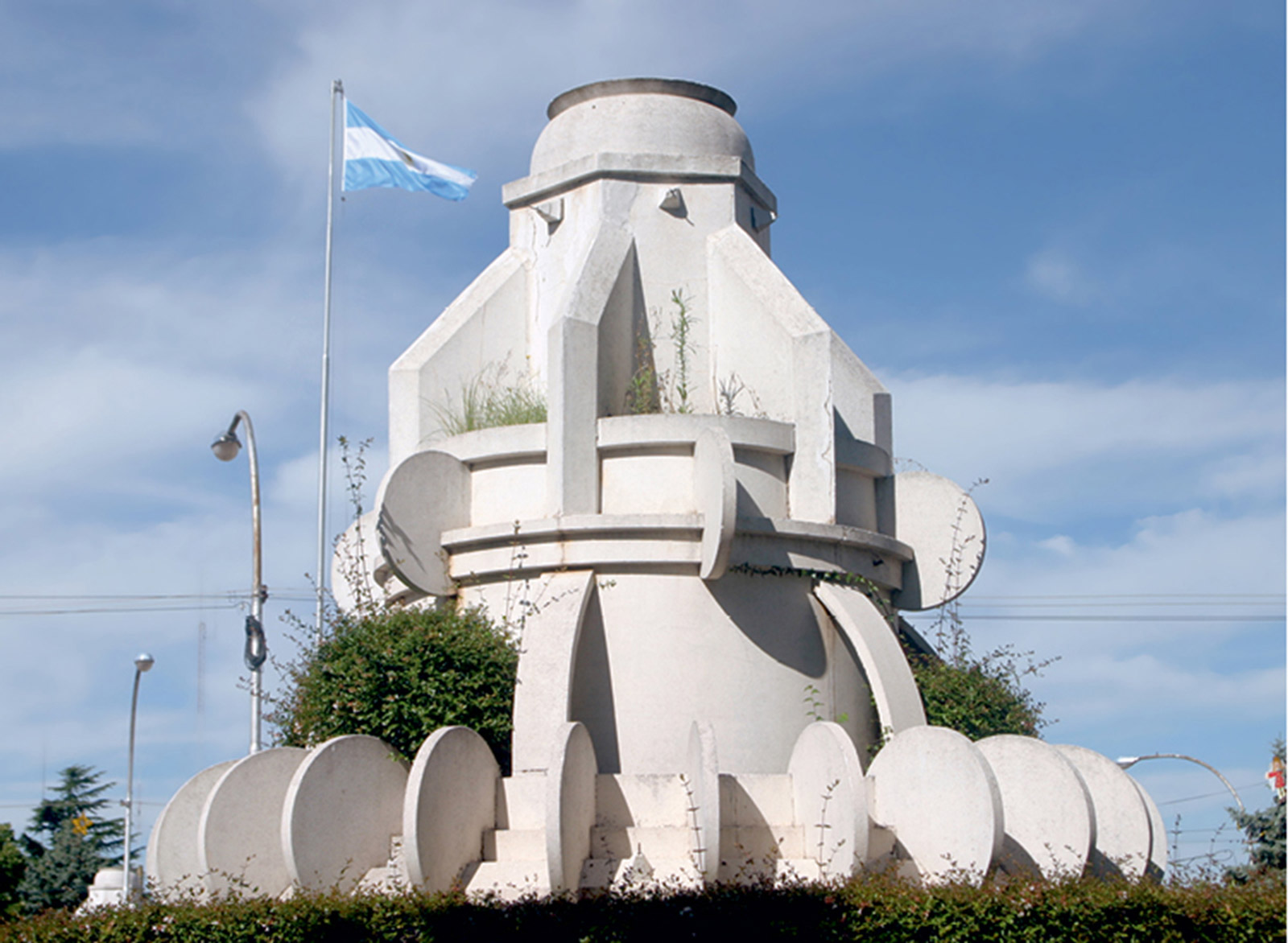
Francisco Salamone, an architect with almost no track record, was given dozens of these smaller commissions. Born in the Sicilian village of Leonforte in 1897, he emigrated to Argentina with his family in 1903, settling first in La Plata, one of the nation’s newest cities, before moving to one of its oldest, Córdoba, where he studied architecture and eventually opened a paving business. Salamone apparently had the right political connections, and, even more, a willingness to work in the middle of nowhere. While his more famous colleague Alejandro Bustillo busied himself in the fancy resort of Mar del Plata, Salamone worked in thirty-one different towns, from Pilar, practically a suburb of Buenos Aires, to Guaminí, a former Indian fort near the provincial border. Many are located in the more isolated interior and bear names drawn from a pan-European roster of generals and entrepreneurs: Laprida and Vedia, Tornquist and Coronel Pringles, Alberdi and Alberti. In an intense burst of activity from late 1936 through 1937, before an inflationary economy and Fresco’s political difficulties slowed Salamone’s efforts, the architect designed and built twenty-seven town halls, seventeen slaughterhouses, seven cemetery portals, two markets, and a school, as well as the lighting and furniture for eleven parks. And then nothing, or almost nothing: after 1940 and a brief political exile in Uruguay, Salamone returned to Buenos Aires, built a few lackluster apartment buildings and did some more paving before his death in 1959.
Even more abruptly than Buenos Aires ends, the towns on the Pampas appear, unmediated by the strip malls that buffer small towns in the US or by the informal taquerías and oily mechanics’ shops that one would find in Mexico. Manuel Puig’s 1969 novel Boquitas pintadas—which centers on a fictional town called Vallejos, a stand-in for General Villegas, located in the extreme northwest of the Province of Buenos Aires, where the author was born in 1932—includes a verbal stampede that gives a sense of how one still approaches these towns today, even if the ride is now much smoother: “The jolt, the backsides, no smoking in this vehicle, the chewing gum, the window, the fields, the wire fence, the cows, the pasture, the corn, the alfalfa, a chaise, a farm, a grocery store, a house, the Gaucho Inn General Store, a field of sunflowers, Social Club-Sports Headquarters, the shacks, the houses.”[3]

Unlike so much of Latin America, rural Argentina is depopulated, the dreams of the pioneers stymied by the nation’s endlessly complex economic history, by the end of immigration and the subsequent exodus of the immigrants’ grandchildren to Buenos Aires, and by the collapse of the railways. The towns seem at once contemporary and locked in time, like sets for a 1940s film marred by a few anachronistic details. Store signs, some with letters cut from now-weathered wood, others crafted from metal and balanced over the street, are individualized, locally made, history-museum-quality relics, reminders of what has been lost in the corporatization and vinylization of signage in most of the developed world. The future in these towns is so absent that there are frequent textual declarations to the contrary—from the Club Progreso in Tres Lomas to the banner reading “El futuro es hoy” on the town hall in Carhué.
As cool as these retro-towns might seem, they are awash in melancholy, which is nothing new judging from Ezequiel Martínez Estrada’s exuberant yet fatalistic analysis of this landscape in X-Ray of the Pampa, first published in 1933: “Those towns are extremely sad and man’s acclimatization is inconceivable in conditions of such spiritual celibacy. There is no need to single out any town; they are all identical and differ only in name and number of inhabitants. Their configuration is the same, and people and houses remind one of birds resting after a long flight.”[4] There is money around—besides seeing some fancy, late-model pick-ups, we are shocked to learn in General Villegas that farm acreage is more expensive here than in Illinois—and local museums, like the Museo del Automovilismo Juan Manuel Fangio in Balcarce and the Museo de Arte Contemporáneo Raúl Lozza in Alberti, commemorate native sons who made it big. Nevertheless, the towns never achieved the promise of growth that their confident founders expected in the 1880s, when they laid out extended geometric plans after the remaining indigenous populations had been “removed” through a brief military campaign known as the Conquest of the Desert. Like railway tracks, telegraph lines, and wire fencing, street grids structured and controlled untamed space, but whereas Buenos Aires slowly but surely occupied its own vast urban plan, the more modest yet similarly optimistic grids on the Pampas were never fully built up. Thus, in these towns today one finds single-family homes—with lawns, open doors, and cars parked in the driveway—and even vacant lots where one might expect a concentration of commercial buildings. Fertilizer stores are given prominence alongside social clubs; streets lead to dirt roads that then fade into the grass. Martínez Estrada described how “every village seems disjointed by the centrifugal force of individual plots” and indeed, on outlying corners, isolated brick houses, set on the grid and tight to the sidewalk, reveal blank side walls that snub the neighbors who never arrived. Like almost no other settled part of the world, there is never a problem parking the car; in the hot humid summer, shirtless blond kids pedal their bikes down the middle of the streets without looking side-to-side at the intersections.

Most of the towns center on a plaza—generally one hectare square—shaded with cedars of Lebanon, horse chestnuts, sycamores, and towering araucarias, and filled with topiary archways and carefully maintained beds of roses, oleander, and other exotics that once reminded immigrants of home. Some follow the English tradition of winding paths, others the French tradition of rigid symmetry, others yet combining the two, with benches and occasional kiosks for selling newspapers, but almost no people, though it can’t be only due to the oppressive heat or winter chill (in Mexico one never sees an empty plaza). There are monuments to the all-too-recent Conquest, erected when there were still a few survivors around, and to local heroes, like Baltimore-born businessman Ernesto Tornquist, who founded an agricultural colony for Germans in 1883, now seated eternally with his legs crossed in the town that bears his name. Another celebrates Coronel Nicolás Levalle, who established a fort in 1876 in what is today Carhué—his equestrian portrait sits on a plinth flanked by full-figure renditions of a blacksmith, a teacher, a soldier, and an Indian, all looking ancient but made of fiberglass and dating only to 1978. The same whitewashed Sower and Reaper turn up again and again, surely ordered from a catalogue. And on every possible surface, bronze plaques commemorate and re-commemorate what little actual history there is.
Salamone intervened in many of these plazas, designing benches, planters, lampposts, pergolas, and sometimes (as in Alberti and Pellegrini), staccato-patterned pavements. In Tornquist he framed an artificial duck pond with illuminated concrete bridges, and apparently when there were extra funds or materials he built crazy flagpole bases and wild multipurpose forms, like those in Laprida and Alberti, trimmed with pre-cast concrete disks and topped by bulging openwork finials, conforming to no known prototypes: painted sugary white, they seem more culinary than architectural, more Buck Rogers than Martín Fierro. Even more than his buildings, these unnamable ornaments, made feasible by the plasticity of poured concrete cast in molds with rebar skeletons, reveal the architect’s creative license, rarely seen even on the most opulent art deco theaters and hotels. Salamone not only brought signs of modernization to these dull towns, he brought them humor and escapism; however seriously he took his task, he must have enjoyed playing with disks and planes as if they were wooden blocks. There is little evidence of the local reception, but only one of these constructions was ever destroyed; it would be hard to imagine the residents of Our Town, USA, ever allowing their taxes to finance such abstract intrusions.

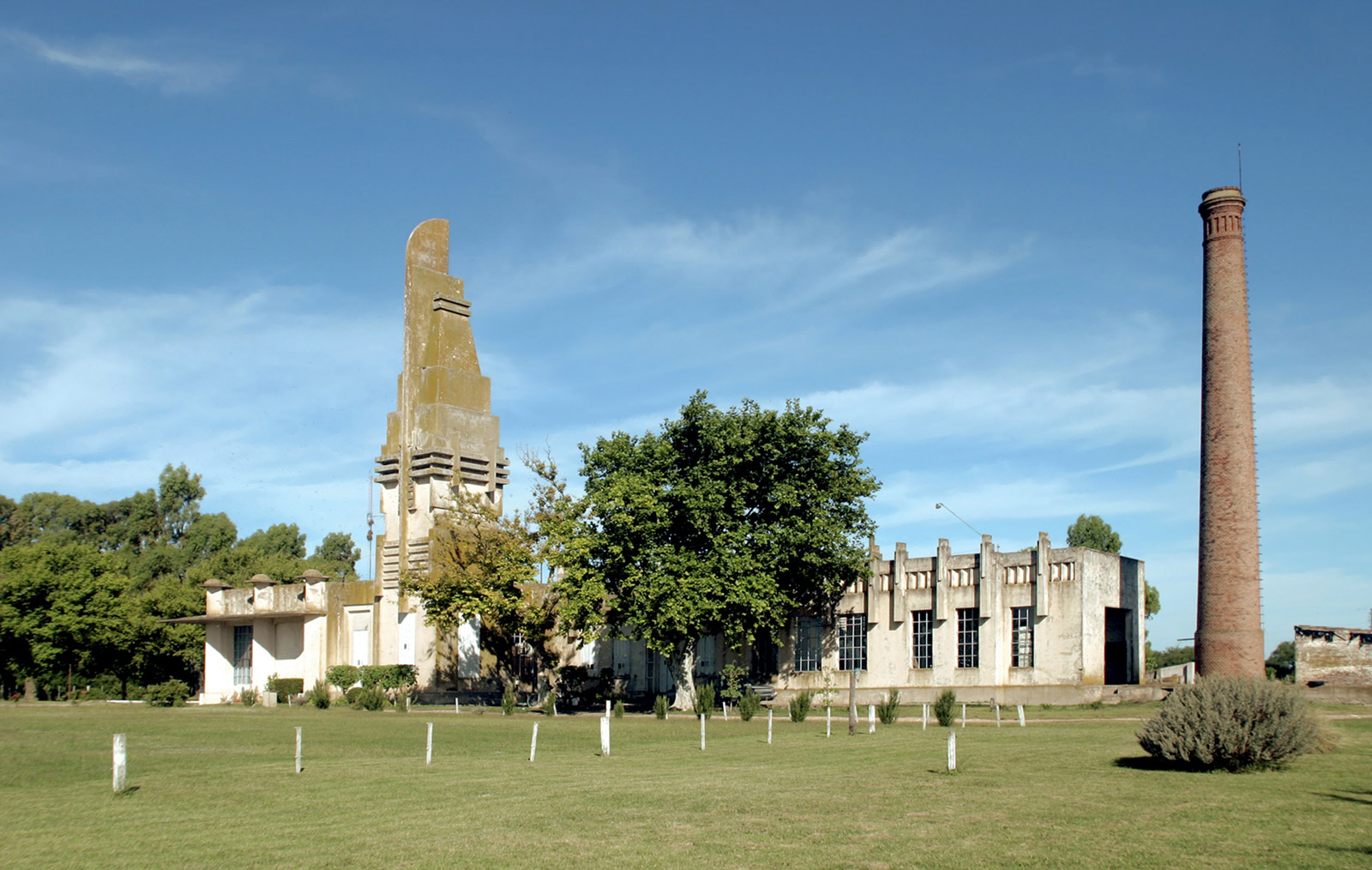
Entering by car, the plaza is always easiest to find in the towns where Salamone built a new town hall, or municipalidad, for at thirty or more meters high, their clock towers are generally the tallest thing around. Most are angular, sliced through with thin horizontals or verticals that create crystalline surfaces on which flocks of birds can roost. The towers, attenuated in Laprida and Pellegrini and composed of stacked balcony-like platforms in Alberti and Guaminí, are reminiscent less of the nearby neo-Germano-Gothic or pseudo-Spanish-Baroque churches than of the stark neoclassical buildings in Sabaudia, one of the new towns Mussolini built in Italy in the similarly flat Pontine Marshes in 1934, a likely model given Fresco’s sympathy for Il Duce. Indeed, though his jazzy referents sometimes dominate, Salamone’s rigidly symmetrical floor plans are ultimately conservative, academic; these buildings are more moderne than modernist; looking more than being modern, like many fascist buildings. Yet Salamone’s architecture is so much more generous and lighthearted; here on the Pampas, verticality seems less an overt assertion of political order, though it was indeed that, than a spirited rejection of merciless boredom (Martínez Estrada called it the “jail of the horizon”). Like Frank Lloyd Wright, that other eccentric modernist of the prairie, Salamone knew that sometimes people want to look up and not across. There was also almost no local history to confront or ignore; only in Chascomús, founded in the eighteenth century and thus ancient in Argentine terms, and in a couple of remote railway outposts did he work in a neo-colonial language (red tile roofs, chunky columns, iron grilles). Elsewhere, none of his buildings relate to anything local since there is basically nothing local to relate to. Guaminí, for example, where he gave the town hall and slaughterhouse somewhat nautical allusions—perhaps because of the nearby Laguna del Monte—is in fact far from the sea.
Given the right-wing politics of the Fresco regime, one is primed to find evidence of fascism out here—a chrome handle on the main entrance to Salamone’s inelegant Escuela No. 1 in Alberti eerily resembles a swastika; a sidewalk café in the town of 25 de Mayo is named “Pétain”—but things aren’t quite so grim. Determining Salamone’s sources is a tricky—and sometimes annoying—sub-theme in the scholarship on the architect, but in visual terms, he was surely inspired less by the severity of Sabaudia than by the commercial buildings of Depression-era America, even if he never traveled to the US. His style owes a debt to the prominent towers and crisp, machine-like elements of hotels and movie theaters in cities like Miami and Los Angeles, to the 1933 Chicago World’s Fair pavilions, and to the ubiquitous Greyhound bus stations, which all alluded to the speed, elegance, and efficiency promised by the future and competed for the public’s attention (and dollars). At a time when the provincial government desperately sought to prevent migration to the cities, Salamone’s buildings were perhaps intended to give the locals sufficient metropolitan excitement, echoing, as they do, such recent Buenos Aires landmarks as the Obelisco and Cine Opera, both completed in 1936. Mirá che, it isn’t so bad living here after all.
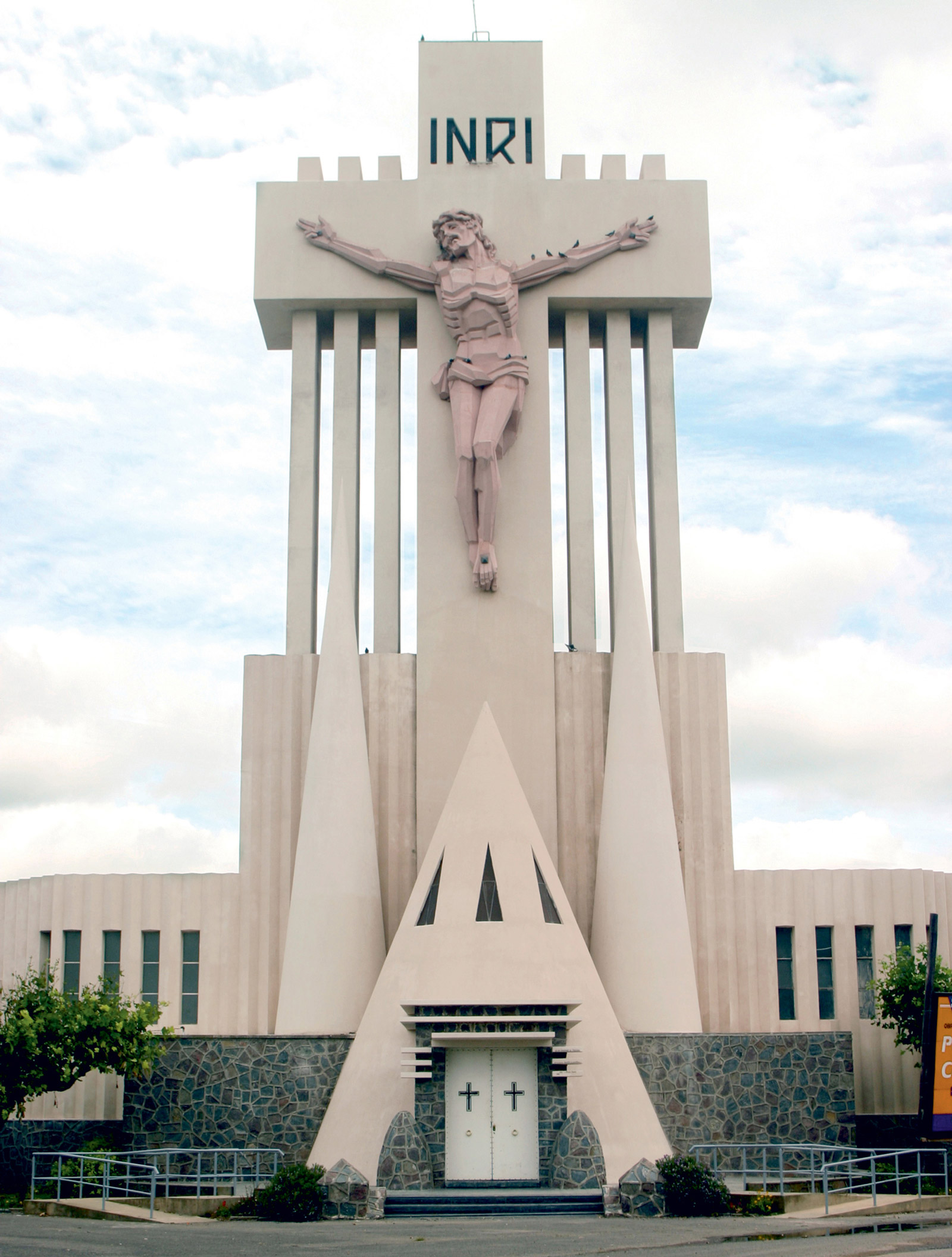
There are other signs of modernity: death is kept at a safe distance outside and at opposite ends of the towns—humans off there to the cemetery, cows over there to the slaughterhouse. Salamone’s colossal cemetery portals are among his best-known monuments, aggressive and theatrical additions that mask the architectural diversity and social divisions of the older cemeteries behind them. The portal in Laprida, taller than the municipalidad and even more out of scale, emerges out of the Pampas like an apparition at the end of a diagonal access road lined with trees and created precisely to provide a perfect vista (Haussmann on the prairie). Like the “assemblage” on the main plaza, here too we have a hybrid: an expressionist sculpture of Jesus, which we later discover is by a provincial artist named Santiago Chiérico, rises over a conical chapel-chamber flanked by two other cones whose sharp points echo the nails that pierced Christ’s wrists. In Saldungaray, the portal is an enormous, blue tiled disk radiating around Jesus’ disembodied head and set perfectly at a bend in the road; in Azul, the letters RIP are rendered in monumental dark stone blocks that dwarf an Angel of Death. There, on a lowery day that makes the place seem sinister, we come across the only other outsiders we ever meet who are also in pursuit of Salamone, an older couple making a detour on their way to the beach. Our experience of Salamone is rarely social, the buildings empty but for the occasional caretaker.
In the end, however, it is Salamone’s slaughterhouses that are most evocative of the melancholic landscape, for the building type has long been essential to the pampean economy and its product still dominates the diet of a nation that remains the world’s greatest consumer of red meat (sixty-seven kilos per capita in 2007). Salamone built seventeen of these little factories dedicated to the task of converting vaca into carne. Although each, surprisingly, has a different floor plan, the slaughterhouses are models of efficiency, allowing mass production (or destruction) under hygienic conditions—another great obsession of the 1930s—and providing a proper work environment for the highly skilled butchers. Like the municipalidades, the buildings all have towers, basically ornamented water tanks: as in the cemeteries, there was a lot of washing, as well as burning, to be done. Allusions to knife blades cut through the sky in Azul and Coronel Pringles, while in Alem and Alberdi, the towers are simply rectangular stumps. The slaughterhouse in Balcarce, with its brutalist pyramid-capped tower, weighs particularly heavy on the land: as elsewhere, its once crisp clean surfaces are now covered by greenish mildew.
As local butchering gave way to industrialized meat manufacturing, all of the slaughterhouses were eventually converted or abandoned. Some are now ruins; the one in Alem, stripped of its metalwork, lies abandoned in the middle of what is now the town dump. Azul’s slaughterhouse became the dog pound; the one in Coronel Pringles seems to have been converted into a private house before becoming a cultural center. Strangest of all, at some point a religious congregation occupied the Balcarce slaughterhouse, before building a church next door—amid the pigeon shit and buzzing wasps, we discover a ruined wooden altar illuminated by broken windows with yellow panes in the shape of a cross. Only one, in Tres Lomas, remains perfectly preserved, and it is the last building by Salamone we visit, only then really understanding just how it all happened: the cattle were shunted one by one from a corral up a wooden ramp leading to a back door, then killed in the metal cajón de noqueo (knockout box) and decapitated, four hundred or so kilos to be strung up by their hind legs by chains attached to hooks mounted on tracks that allowed them to be efficiently bled onto the sloping and easily mopped floors, then moved in a disassembly line through the central hall to be butchered before finally exiting the front doors as steak.[5]

Marginality sometimes condemns one to oblivion: if these buildings were in the American Midwest, they would be the subject of many a monograph. But marginality also facilitates preservation, even in the case of the slaughterhouses. In many of these towns, the Fresco-era buildings seem to be the last major constructions and there was never really any reason to update them, replace them, or tear them down before they finally began to be recognized as just about the only thing around that might attract a tourist or two. In some places, they have become markers of local pride, and remain—with the possible exception of a giant carp by the lakeshore in Guaminí and a brontosaurus in a playground in Balcarce—the most photogenic landmarks on the Pampas.
Manuel Fresco’s political vision, as concretized by Salamone, resonates with other construction projects of the 1930s that sought to shore up confidence during the economic depression or that gave somewhat peripheral cities, like Casablanca, Havana, or Tel Aviv, a veneer of ultra-modernity. The US federal building program of the New Deal erected new post offices and courthouses in communities across the country, though their facades were usually as calm and regionalist as the murals in their lobbies. The designers of new cities and spaces in Italy and Germany tended towards more rigidly classicizing models, with no sense of humor or toleration of individual eccentricity, although the Italian architects working in Eritrea in the 1930s found space for their own concrete flights of fancy. For originality in that era, one was better off in the world of leisure, as along Ocean Drive in Miami Beach, where the hotels and apartment buildings, though densely packed and competitive, resonate with Salamone’s aesthetic. Above all, Salamone’s towers form distant allegiances with those other beacons of modernity of the period, from Mallet-Stevens’s Tourism Pavilion for the 1925 Exposition des Arts Decoratifs to Diulgheroff’s more radical “Lighthouse to Mark the Victory of the Machine” of 1927, all of which signaled a way of living that never really arrived, and that really never arrived in the Pampas. In the end, Salamone’s buildings, like the towns they inhabit, symbolize a truncated, or perhaps just superficial grasp at modernity, as thin as the new coat of paint on the exterior of the municipalidad in Coronel Pringles. The modern monuments that ultimately triumphed were not Salamone’s, but the gleaming metal grain depots of multinationals like Cargill and Syngenta, their silos sometimes visible from empty town plazas.
- Argentine historian Alberto Bellucci, American writer Edward Shaw (who organized an exhibition on Salamone in 1997), and Pastorino (whose series of bichromate gum prints from 1998 to 2001 are one of the landmarks of contemporary Argentine photography) were all crucial in bringing Salamone to wider public attention. See Bellucci, “Monumental Deco on the Pampas: The Urban Art of Francisco Salamone,” The Journal of Decorative and Propaganda Arts, no. 18, 1992, pp. 90–121; and Shaw, Francisco Salamone Resurge (Buenos Aires: Centro Cultural Borges, 1997).
- Alejandro Novacovsky, et al., Francisco Salamone en la Provincia de Buenos Aires, 2 vols. (Mar del Plata: Universidad Nacional de Mar del Plata, 2001–2004). To place Salamone in a wider context, see Jorge Francisco Liernur’s comprehensive, and equally weighty, Arquitectura en la Argentina del siglo XX: La construcción de la modernidad (Buenos Aires: Fondo Nacional de las Artes, 2001).
- Manuel Puig, Heartbreak Tango, trans. Suzanne Jill Levine (New York: Penguin Books, 1973), p. 109. The original title, literally “Little Painted Mouths,” refers to the red puckered lips of flappers and tango dancers.
- Ezequiel Martínez Estrada, X-Ray of the Pampa, trans. Alain Swietlicki (Austin: University of Texas Press, 1971), p. 127.
- The process is thoroughly described in Juan José Becerra, La Vaca: Viaje a la pampa carnívora (Buenos Aires: Arty Latino Ediciones, 2007), pp. 133–139.
James Oles divides his time between Mexico City and the Boston suburbs, where he teaches the history of Latin American art at Wellesley College. His most recent projects include Shouts from the Archive: Political Prints from the Taller de Gráfica Popular (Colección Blaisten, 2008) and retrospectives of artists Agustín Lazo at Colección Blaisten and Pedro Friedeberg at Museo de Arte Moderno.
Spotted an error? Email us at corrections at cabinetmagazine dot org.
If you’ve enjoyed the free articles that we offer on our site, please consider subscribing to our nonprofit magazine. You get twelve online issues and unlimited access to all our archives.